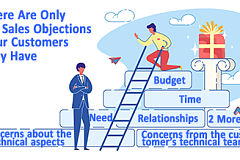How to Handle Time Objections:
1. Acknowledge and Empathize:
Begin by acknowledging the importance of their time. Express understanding of their concerns and make it clear that you appreciate their time is valuable.
2. Clarify and Uncover:
Ask open-ended questions to understand the specific reasons behind their time concerns. Are there particular aspects they find time-consuming or are they unsure about the value they'll receive?
3. Present a Clear Value Proposition:
Clearly articulate the value of the meeting or interaction. Highlight how your product, service, or discussion can directly address their pain points, save them time in the long run, or bring about positive outcomes. Tailor your value proposition to align with their needs and priorities.
4. Focus on Solutions:
Once you understand their concerns, focus on solutions. If time efficiency is a priority for them, emphasize how your offering streamlines processes or provides quick and effective solutions.
5. Offer Flexibility:
Provide options for a meeting that can accommodate their schedule. Whether it's a shorter initial meeting, a flexible time slot, or the possibility of a virtual meeting to save commuting time, show that you're willing to work within their time constraints.
6. Social Proof and Success Stories:
Share relevant success stories or examples where others initially had time concerns but found significant value in the interaction. This can help build confidence and demonstrate that the investment of time has yielded positive results for similar individuals or organizations.
7. Address Value Perception:
If the time objection persists, address any potential misperception regarding the value they'll gain. Reiterate and, if necessary, provide additional details about the specific benefits they stand to receive from the meeting or interaction.
8. Time-Limited Commitment:
Offer a time-limited commitment for the initial meeting. Assure them that you respect their time, and that the discussion will be focused, with a clear agenda and timeframe.
9. Follow-Up with Relevant Materials:
To reinforce the value proposition, follow up with relevant materials that further illustrate how your product or service addresses their needs and saves them time.
10. Continuous Improvement:
Use feedback from objections to continuously improve your approach. If you frequently encounter time objections, analyze patterns and adjust your initial pitch or communication strategy accordingly.
11. Adapt Based on Feedback:
If they express reservations about time, adapt your approach based on their feedback. This shows responsiveness and a commitment to addressing their concerns.
12. C.T.A.P.S.- Positioning Statement
"Congratulations on your [recent achievement/accomplishment]! Confirm the Time by asking if the time allotted is still available. On the Agenda have 3 – 5 points, ask is there one item that they want to tackle first. Permission when we get on the other side of this meeting, and you don’t feel it’s a fit you’d be okay with telling me that it’s not a fit wouldn’t you? The reason for asking is it seems at times people don’t want to hurt my feelings, so they say they want to think it over.
Solution to delve into a discussion about how [your product/service] can offer a tailored solution to address those specific needs that benefits them the prospect?"
Feel free to customize it further based on your specific product or service and the context of your sales conversation.
Keep in mind the D.E.F.E.A.T.S. approach that we presented early on in the series of articles. It’s important to have evidence that supports the perceived claims that you make during the sales conversations.
Remember, the key is to build trust and demonstrate that the time invested will result in tangible benefits. Adjust your approach based on individual circumstances, and consistently refine your strategy based on feedback and results.
-Courtesy, Coach Phil










